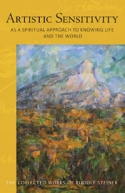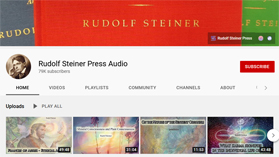
-
ARTISTIC SENSITIVITY AS A SPIRITUAL APPROACH TO KNOWING LIFE AND THE WORLD
Rudolf Steiner

Today’s orthodox notions of science—which is to say, of knowing—are exceedingly narrow; they posit, implicitly or otherwise, that the only knowledge possible, if any, is that of the physical world. But the skeleton key to unlocking the door, behind which lies the root of the problems and difficulties of our age, and thus their solution, is to be able to fully answer this question: What is it to know something? This question lies at the foundation of spiritual science. Rudolf Steiner had first to solve it for himself, pointing the way for others to do the same (in, for example, his Philosophy of Freedom), long before he could give such lectures as these.
Rudolf Steiner’s work and words, still largely undiscovered as compared to their value for humanity, continue to point the way toward a different path—a way of knowing that encompasses the fullness, the breadth and depth of life and the worlds we inhabit. This knowing—which is to say, science—does not ignore or even contradict the narrower physical sciences of technologists and other sp (ecialists, but offers an expansive understanding of reality that also includes a deeper engagement with those aspects of our experience that we are told are beyond the ken of science. But is truth not accessible through art? Are poetry and literature, indeed the beauty and wisdom of each human language, not portals through which we can glimpse truths, every bit as real (though of a different order) than those we might grasp through a microscope?
These thirteen lectures were given in Dornach, Switzerland, from January to May 1915, between the fifth and ninth month of World War I. Given the interrupted, fragmented nature of this sequence, one might assume that the lectures could not possibly present a tight, coherent whole. This is not the case. Rudolf Steiner lays down the framework for the series in a concise but detailed manner in the first two lectures, and then goes on to demonstrate in lecture after lecture how, on this basis, many aspects of life reveal the hidden presence and activities of the realities—and the approach—he has established in the framework. In fact, it is humbling to witness Rudolf Steiner’s powers of attention and presence of mind: to see how, after a significant interval, in the same tone of voice and with seamless continuity, he can pick up and further develop and interweave his announced intention: namely, to provide “a detailed look at things we have been considering for years.”
Artistic Sensitivity as a Spiritual Approach to Knowing Life and the World is a translation from German of Wege der geistigen Erkenntnis und der Erneureung künstlerischer Weltanschauung (GA 161). Front Cover Image:Mont Sainte-Victoire as Seen from les Lauvres, oil on canvas, 1906, by Paul Cezanne (1839-1906). National Pushkin Museum, St. Petersburg, Russia.
26 June 2018; (GA 161); SB; 332pp; 23 x 15 cm; pb;
£22.50 ISBN 9781621481775

